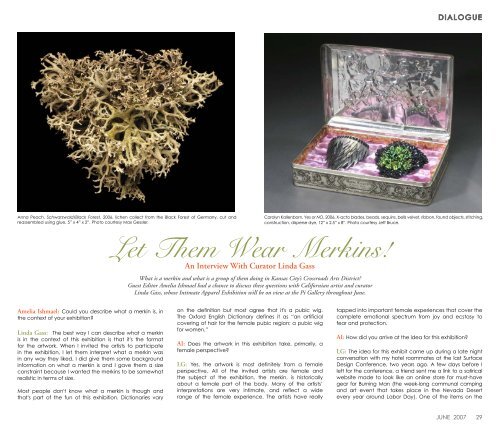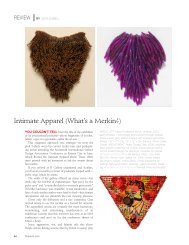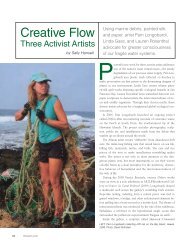Let Them Wear Merkins! - Linda Gass
Let Them Wear Merkins! - Linda Gass
Let Them Wear Merkins! - Linda Gass
You also want an ePaper? Increase the reach of your titles
YUMPU automatically turns print PDFs into web optimized ePapers that Google loves.
D I A L O G U E<br />
Anna Peach, Schwarzwald/Black Forest, 2006, lichen collect from the Black Forest of Germany, cut and<br />
reassembled using glue, 5” x 4” x 2”. Photo courtesy Max Gessler.<br />
Carolyn Kallenborn, Yes or NO, 2006, X-acto blades, beads, sequins, bells velvet, ribbon, found objects, stitching,<br />
construction, disperse dye, 12” x 2.5” x 8”. Photo courtesy Jeff Bruce.<br />
<strong>Let</strong> <strong>Them</strong> <strong>Wear</strong> <strong>Merkins</strong>!<br />
An Interview With Curator <strong>Linda</strong> <strong>Gass</strong><br />
What is a merkin and what is a group of them doing in Kansas City’s Crossroads Arts District?<br />
Guest Editor Amelia Ishmael had a chance to discuss these questions with Californian artist and curator<br />
<strong>Linda</strong> <strong>Gass</strong>, whose Intimate Apparel Exhibition will be on view at the Pi Gallery throughout June.<br />
Amelia Ishmael: Could you describe what a merkin is, in<br />
the context of your exhibition?<br />
<strong>Linda</strong> <strong>Gass</strong>: The best way I can describe what a merkin<br />
is in the context of this exhibition is that it's the format<br />
for the artwork. When I invited the artists to participate<br />
in the exhibition, I let them interpret what a merkin was<br />
in any way they liked. I did give them some background<br />
information on what a merkin is and I gave them a size<br />
constraint because I wanted the merkins to be somewhat<br />
realistic in terms of size.<br />
Most people don't know what a merkin is though and<br />
that's part of the fun of this exhibition. Dictionaries vary<br />
on the definition but most agree that it's a pubic wig.<br />
The Oxford English Dictionary defines it as “an artificial<br />
covering of hair for the female pubic region; a pubic wig<br />
for women.”<br />
AI: Does the artwork in this exhibition take, primarily, a<br />
female perspective?<br />
LG: Yes, the artwork is most definitely from a female<br />
perspective. All of the invited artists are female and<br />
the subject of the exhibition, the merkin, is historically<br />
about a female part of the body. Many of the artists’<br />
interpretations are very intimate, and reflect a wide<br />
range of the female experience. The artists have really<br />
tapped into important female experiences that cover the<br />
complete emotional spectrum from joy and ecstasy to<br />
fear and protection.<br />
AI: How did you arrive at the idea for this exhibition?<br />
LG: The idea for this exhibit came up during a late night<br />
conversation with my hotel roommates at the last Surface<br />
Design Conference, two years ago. A few days before I<br />
left for the conference, a friend sent me a link to a satirical<br />
website made to look like an online store for must-have<br />
gear for Burning Man (the week-long communal camping<br />
and art event that takes place in the Nevada Desert<br />
every year around Labor Day). One of the items on the<br />
JUNE 2007 29
D I A L O G U E<br />
Wendy Huhn, Safety 1st, 2006, cotton thread, silk flowers, beads, cotton fabric, timtex as batting, hand<br />
embroidery, stitching, xylene transfers, beading, 7.5” x 6” x 1/8”. Photo courtesy the artist.<br />
Susan Friedland, Worn, 2006, burnt linen, hemp twine, hand quilted french knots, 5.5” x 5.5” x 1/4”. Photo courtesy<br />
the Hansine Pederson Goran.<br />
website was a "Flashlight Merkin" complete with a photo<br />
of a woman's torso modeling this pink fur patch with an<br />
LED headlamp attached to it. Any woman who has gone<br />
to Burning Man can appreciate what a useful hands free<br />
item this would be for the porta-potties at night but, when<br />
I shared the joke with my hotel roommates, they didn't<br />
know what a merkin was and didn't believe me when I<br />
told them it was a real thing. I had heard of a merkin<br />
before but I had to admit that I didn't really know how<br />
and why it came into being.<br />
The next day I did a little bit of research on the internet<br />
and learned that the merkin goes back many centuries<br />
to a time when pubic lice were a common problem and<br />
women would have to shave their pubic hair to relieve the<br />
itching and eradicate the lice. <strong>Merkins</strong> were then invented<br />
to replace the shaved hair, so the women wouldn't feel<br />
bare. Then, prostitutes got hip to the fact that merkins<br />
could be used to cover up the marks of syphilis and<br />
genital warts and they could appear to be disease-free<br />
and therefore, still employable. My roommates were<br />
amazed to learn this and were still a little skeptical so<br />
we started discretely asking other conference attendees<br />
if they knew what a merkin was. We got some very<br />
interesting answers and only one other person actually<br />
knew what a merkin really was. One of the most hilarious<br />
answers came from the British husband of one of my<br />
roommates. My roommate was sure that her husband<br />
would know what a merkin was, since she thought it<br />
sounded like a British word, kind of Shakespearean. She<br />
called him on her cell phone late at night after we had<br />
gone out to dinner and unintentionally woke him up. She<br />
asked if he knew what a merkin was and being the good<br />
humored sort of man that he is, rather than hanging up<br />
the phone in disgust, he said “it’s what President Bush<br />
calls the people who live in this country.”<br />
Once all of this talk of merkins started, we really couldn't<br />
stop, and because we're all artists, we started coming up<br />
with wild ideas of what could be a merkin. Then we found<br />
out that the theme for the next conference was going to<br />
be "Mind and Body" and that's when the idea of creating<br />
an exhibit of merkins really solidified.<br />
AI: What sorts of issues do the artists you have selected<br />
for this exhibition approach in their works?<br />
LG: There is such a wide range of issues covered<br />
— which I'll tell you about in a second — but first, I want<br />
to say that I didn't ask the artists for statements about<br />
their merkins and like all good art, the works speak for<br />
themselves, and everyone may view them differently.<br />
That said, I see many issues being addressed such<br />
as fertility, shame, power struggles and domination,<br />
flirtation and seduction, voyeurism, and pleasure. Many<br />
of the pieces use humor to address their issues — some<br />
are very direct in their humor through use of illustrative<br />
graphics. Others are more subtly humorous through their<br />
choice of materials or the title they have given to their<br />
piece. Some of the works look at the stages of our lives<br />
and the impact that has on our sexuality and sense of<br />
womanliness — whether it's being young, attractive and<br />
seductive or growing old with a life full of experiences or<br />
being in the circumstance of a long distance relationship.<br />
Two of the works are representations of fig leaves<br />
— making the Biblical connection of merkin as coverup<br />
and all of the issues that go with covering something<br />
up: shame, self-esteem, modesty, vulnerability. It's<br />
interesting for me to observe that many of the works<br />
have a "dangerous" quality to them — mostly through their<br />
choice of materials but sometimes through their imagery.<br />
We're clearly dealing with a "dangerous" part of the body<br />
here and those artists addressed that straight on. Many<br />
of the works have a messenger quality to them — they<br />
communicate a specific message to an intended viewer<br />
30 JUNE 2007
D I A L O G U E<br />
of a merkin before I invited them to participate but a few<br />
were already familiar with what it was. In fact, one of the<br />
artists told me that she's been looking for a specimen of<br />
a real merkin in museum collections around the world for<br />
the past ten years and she has yet to find one. From the<br />
very beginning, it's been so much fun to work with the<br />
invited artists on this exhibit. I invited some artists who I knew<br />
personally or had some prior contact with but half of the<br />
artists were people who I basically cold-called to invite.<br />
Their responses to my invitation were so enthusiastic and<br />
oftentimes they had funny stories to share around the<br />
topic, especially once they learned what this was. I was<br />
amazed to learn that some of them had already made a<br />
merkin (one made a quilted merkin for a friend who had<br />
a hysterectomy and she didn't want her to catch cold after<br />
they shaved her for the surgery).<br />
AI: The exhibition’s title, Intimate Apparel, implies that<br />
the merkin is worn. Did the artists involved work with how<br />
their works could be attached to the body?<br />
Hollie Heller, So to Speak, 2006, Collage with gloss medium, text, painted<br />
paper fiber, stitching, 6” x 7“ x 1”. Photo courtesy the James Dee.<br />
— some are literally instructive, and some indicate mood<br />
or receptiveness.<br />
AI: What types of material and processes are used in the<br />
pieces on exhibit?<br />
LG: The range of materials is wildly diverse. In addition<br />
to fabrics such as velvet, silk, cotton and lace, the artists<br />
have used beads, sequins, human hair, X-acto blades,<br />
silicone fishing bait, bobby pins, pine cone scales,<br />
chrysanthemum stamens, lichen collected from the<br />
Black Forest, seaweed, glass eyes, fish skin, vintage keys,<br />
match sticks, mirrors, aluminum, copper wire, rusted<br />
metal washers, and plastic and glass fruit.<br />
The techniques used are equally diverse and include<br />
weaving, embroidery, crochet, quilting, fusing, felting,<br />
basketry, silkscreening, monoprinting, marbling,<br />
beading, sewing, bookmaking, painting, casting,<br />
burning, and mixed-media assemblage.<br />
One of the merkins will literally come to life during the<br />
exhibit; it's made of moss and seeds and visitors to<br />
the gallery will be able to interact with the merkin by<br />
Robin Cowley, Bait, 2006, purple silicone fishing worms, industrial black<br />
plastic screening, canvas, 6” x 10” x 3”. Photo courtesy the Don Tuttle.<br />
spraying water on it to help it grow during the duration<br />
of the exhibit.<br />
AI: In your research did you come across any companies<br />
seriously producing merkins as a commodity?<br />
LG: Before I approached any of the artists to invite them to<br />
participate, I put together an informational website about<br />
the exhibit including information about merkins. Some of<br />
the early artists I invited wanted to see photos of actual<br />
merkins and so I found some on the internet. I actually did<br />
find a company that sells wigs that offers merkins that are<br />
made to look like real pubic hair. There are also a couple<br />
of websites out of the UK that sell decorative merkins<br />
— ones that look like dyed fur in different designs such as<br />
rainbows, bulls-eyes and happy faces.<br />
AI: Have any of the artists who were invited to create<br />
pieces for this exhibition worked with this subject matter<br />
previously?<br />
LG: Yes, two of the artists have made merkins before. In<br />
fact, one of the merkins in the exhibit was made seven<br />
years ago. Most of the artists I invited had never heard<br />
LG: I agree that the title does sound like we might have<br />
created wearable art, however that wasn't a requirement<br />
of the exhibition, and it was never implied that the artists<br />
had to make merkins that could be worn. Some of the<br />
artists have created pieces that could actually be worn<br />
but most did not. The exhibition was really more about<br />
the concept and interpretation of a merkin rather than<br />
creating a real piece of wearable art. As a result of not<br />
making this wearable constraint, I think it's a very strong<br />
exhibit — I mean, some of these merkins would be<br />
downright scary to wear yet their message is extremely<br />
powerful because of this. Just in case you're wondering<br />
how real merkins are attached to the body, they are done<br />
in the same way as false mustaches, with spirit gum.<br />
AI: Could you tell us about one of your personal favorite<br />
works in the show?<br />
LG: I'd be happy to tell you about all 37 of my personal<br />
favorite works in the show. Seriously, I find it impossible<br />
to choose a favorite because the artists have exceeded<br />
my expectations in terms of what they have created. Each<br />
time photographs from an artist arrived in my mailbox,<br />
I was blown away by what they had done — it was like<br />
receiving the most incredible gifts for weeks on end. And<br />
I think the artists themselves are really pleased with what<br />
they've created within this theme. Originally I asked each<br />
artist to only make one merkin but I later gave them the<br />
option to make more than one in the event that there was<br />
space in the gallery. Some of the artists made three or<br />
four merkins — I was just astounded by the response and<br />
creativity I was getting.<br />
JUNE 2007 31




